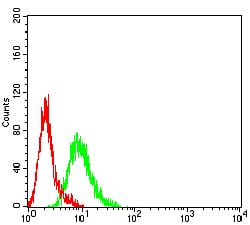

| WB | 咨询技术 | Human,Mouse,Rat |
| IF | 咨询技术 | Human,Mouse,Rat |
| IHC | 咨询技术 | Human,Mouse,Rat |
| ICC | 技术咨询 | Human,Mouse,Rat |
| FCM | 1/200 - 1/400 | Human,Mouse,Rat |
| Elisa | 1/10000 | Human,Mouse,Rat |
| Aliases | AML1; CBFA2; EVI-1; AMLCR1; PEBP2aB; CBF2alpha; AML1-EVI-1; PEBP2alpha |
| Entrez GeneID | 861 |
| clone | 6C12A5 |
| WB Predicted band size | 48.7kDa |
| Host/Isotype | Mouse IgG1 |
| Antibody Type | Primary antibody |
| Storage | Store at 4°C short term. Aliquot and store at -20°C long term. Avoid freeze/thaw cycles. |
| Species Reactivity | Human |
| Immunogen | Purified recombinant fragment of human RUNX1 (AA: 237-337) expressed in E. Coli. |
| Formulation | Purified antibody in PBS with 0.05% sodium azide |
+ +
以下是3篇与RUNX1抗体相关的代表性文献的简要信息:
1. **文献名称**: "RUNX1 mutations in acute myeloid leukemia"
**作者**: Ichikawa M 等
**摘要**: 本研究利用抗RUNX1抗体进行Western blot和免疫组化,发现RUNX1突变导致其在白血病细胞中的核定位异常,并影响造血分化功能。
2. **文献名称**: "Dynamic regulation of Runx1 expression in hematopoiesis"
**作者**: Okuda T 等
**摘要**: 通过抗RUNX1抗体的免疫荧光和流式细胞术,揭示RUNX1在小鼠胚胎造血过程中时空特异性表达模式,及其与干细胞分化的关联。
3. **文献名称**: "RUNX1 interacts with BRD4 to maintain acute myeloid leukemia"
**作者**: Wang L 等
**摘要**: 使用RUNX1抗体进行ChIP-seq和免疫共沉淀,证明RUNX1与表观调控因子BRD4在白血病细胞中存在直接相互作用,共同调控致癌基因表达。
(注:以上文献信息为基于领域知识的概括性描述,实际引用时建议通过PubMed等数据库核实具体文献)
The RUNX1 antibody is a crucial tool in studying the RUNX1 protein, a transcription factor encoded by the RUNX1 gene (Runt-related transcription factor 1). RUNX1. also known as AML1. belongs to the RUNX family and plays a pivotal role in hematopoiesis, regulating blood cell differentiation and development. Dysregulation or mutations in RUNX1 are strongly associated with hematologic malignancies, particularly acute myeloid leukemia (AML), and are implicated in solid tumors. The antibody enables detection and analysis of RUNX1 expression, localization, and interactions in both normal and pathological contexts.
Antibodies targeting RUNX1 are widely used in techniques like Western blotting, immunohistochemistry (IHC), immunofluorescence (IF), and chromatin immunoprecipitation (ChIP). Epitope specificity varies; some recognize the N-terminal Runt domain critical for DNA binding and CBFβ interaction, while others target C-terminal regions involved in transcriptional regulation. Researchers often select clones based on application requirements—e.g., ChIP-grade antibodies must recognize native epitopes, whereas Western blot antibodies may target denatured linear sequences.
Validation of RUNX1 antibodies is essential due to potential cross-reactivity with other RUNX family members (RUNX2. RUNX3) or splice variants. Knockout cell lines and competitive inhibition assays are commonly used for specificity confirmation. Clinically, these antibodies aid in diagnosing RUNX1-related disorders and evaluating therapeutic targets. However, variability in antibody performance across commercial sources underscores the need for rigorous optimization in experimental settings.
×